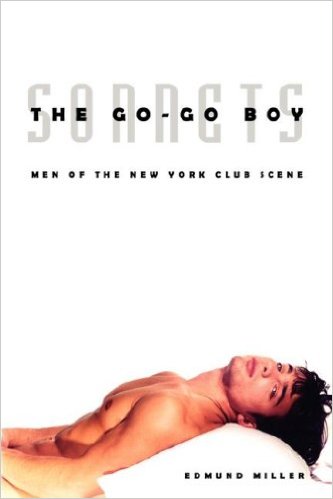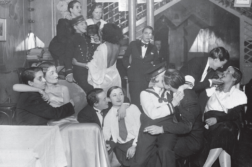 The Go-Go Boy Sonnets
The Go-Go Boy Sonnets
by Edmund Miller
Inkwater Press. 312 pages, $24.95
SIR PHILIP SIDNEY supposedly said, “Only a fool has never written a sonnet, and only a fool has written more than one sonnet.” But Sidney wrote scores of them, and Shakespeare penned over 150. Edmund Miller has surpassed both poets in sheer quantity. Moreover, 75 of Miller’s sonnets are translated in this new book—into no fewer than 24 different languages, including Chinese, Farsi, Hebrew, Albanian, Tagalog, Swordspeak (whatever that is), and Pig Latin. Miller did two-thirds of the translations himself.
A first-person narrator, presumably Miller himself, appears in most of the poems, each a hands-on investigation of the New York go-go boy scene. Here’s a fragment from “Night Shift”: “I figure he’s trade, selling cold clichés—/ Till he warms me in unexpected ways/ While I heft his thick masculinity.” Some people get all the luck in their choice of “research,” and to know that Miller’s university funded his work with no fewer than three grants should make many academics rethink their areas of specialization.
Lest one think that Miller’s research subjects were all down on their luck and worked the bars to supply a drug habit, it is only necessary to read the bios that accompany the poems to realize that most of them are people of quality. No one goes to jail. No one dies of an overdose. Many are in college or beyond: “An M.F.A. in music composition and an accomplished piano player and songwriter, Pat no longer works as a consultant valuing benefits for pension plans.” If nothing else, Miller has brought a kind of dignity to what mainstream America assumes to be mere sleaze. At the same time, these bios may shatter the illusions of some gay men regarding this world. How devastating, for example, to encounter by day, working as a pension plan officer, the boy whose g-string you snapped the previous Saturday night at Splash. Undoubtedly too, some of the boys will be honored to find themselves the center of attention in iambic pentameter instead of catcall sounds.
The apparatus of the book may be a little overwhelming for some readers. There are eight appendices. “The Glossary of Gay Terms and Bar Slang” may be helpful to neophytes, but most readers will not need a definition for “drag” or “pecs” (though “gunsel” or “rice queen” may stump some people). Some of Miller’s definitions carry the insouciance of Dr. Johnson, to wit, a DJ is “a sadist who enjoys inflicting pain on anonymous patrons of dance clubs through the medium of soul-numbing noise.” Another index cites the various allusions in the poems: if you want to know how often Paradise Lost or Cole Porter appears in the sonnets, the pagination is supplied. My favorite list is the “Index of Occupations and Types.” If you’re in the mood to read a poem about an “Albanian melon merchant” or an “Inca exotic,” this is the list to consult. There’s also a list of all the go-go boys immortalized in the verses, but sadly there’s neither an index of titles nor of first lines.
Miller is not the first sonneteer to lionize pretty boys, but he is the first to capture so many of them in verse. Shakespeare sustained his lust for a young man throughout 126 sonnets, and Richard Barnfield immortalized his Ganymede in twenty, but neither man attempted to become the poetic voyeur of a city-wide go-go boy scene. Unlike Shakespeare and Barnfield, Miller has not created a sonnet sequence: there is no narrative link between his poems. Thus it’s not necessary to begin the book at the beginning and read to the end. Miller, in fact, did not construct the book chronologically: the first poem written was “Nick’s Workout Routine,” but it appears as number eleven in the book, and one of the most recent poems, “Look for the Union Label,” appears early in the book.
Miller has never been shy about publishing soft porn. In fact, his list of publications usually references his Honcho and Inches stories alongside his scholarly books on the Renaissance priest George Herbert. One wonders if Miller is not, therefore, commenting on his own motivation when he writes of one go-go boy: “Marcelo lists in his biography—/ Alongside dance—his film pornography:/ What gets you noticed just can’t/ be taboo” (“You Have to Draw the Line Somewhere”). Certainly Miller has never backed down from controversy. His 1973 book of poetry Fucking Animals caused a stir when it was circulated in manuscript, but came to be accepted over the years and was published in 1994 by the Florida Literary Foundation.
Every one of the 167 poems has the same basic subject, a go-go boy, and the same basic plot, a visit by the narrator. The variety of the sonnets derives from the biographical data woven into each piece, but the sheer number of poems is finally a little overwhelming. With every turn of the page, a new boy emerges and the previous one disappears. In traditional books of sonnets, the brain accumulates details slowly to assemble a picture of, say, Sidney’s Astrophil or Shakespeare’s young man. Each of Miller’s boys, on the other hand, gets a mere fourteen lines and then exits the scene.
We can only hope that Miller’s plan to come out with a new edition of the book, including photos of all the boys, will materialize soon. Actually, he has already tested the waters: in 1998 he circulated in manuscript twenty of the go-go boy sonnets accompanied by Xeroxed photos of the boys (Icons of Gay New York). The effect was stunning, and it was only the reluctance of several publishers that prevented the poem-photo approach from being used for the present book. So the sonnets are now in print and simply await high quality photos (which already exist but are not generally available). The sooner the two sets are married, the better off the world of gay poetry will be. I suspect that when the photographic edition does appear Miller will drop the 75 translations—they add nothing to the book except to show that the poet was able to present certain dancers with a copy of their poem in their native language. But there is little point for general readers to read in Norwegian a poem that they have just read in English.
Teetering between doggerel and camp, some of the pieces will be dismissed as secondary artifacts, but others will be remembered, if not outright memorized, for their poignancy and craft. The result of Miller’s six-year labor is a series of poems that display far too much passion and wit to be dismissed as a mere gimmick.
George Klawitter, author of The Enigmatic Narrator, a study of same-sex love in John Donne’s poetry, teaches literature at St. Edward’s University in Austin, Texas.






